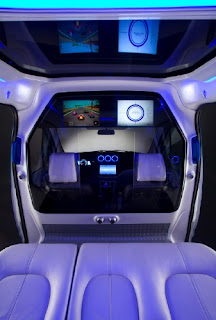2011 Transit Connect wagon
What's New for 2011 FORD
For the 2011 Ford Transit Connect, the entry-level XL Wagon passenger van has been dropped, while a new XLT Premium Wagon model debuts. Foglights are now standard on passenger versions.Introduction OF CAR
Spend any time in Europe and you're bound to notice all kinds of quirky vehicles that aren't sold stateside. That list got a little shorter last year, however, with the U.S. debut of the Ford Transit Connect van.Like most European-bred vans, the 2011 Ford Transit Connect is all about packing maximum functionality into minimum space. While it won't win any beauty contests -- imagine the unholy spawn of a Dodge Sprinter and a Ford Fusion crunched in a trash compactor -- its compact exterior dimensions, fuel-efficient four-cylinder engine and large cargo area with a tall roof and low load floor make it a tremendously useful alternative to traditional V8-powered cargo vans.
2011 Transit Connect wagon.
Cargo versions can be outfitted with a wide range of work-friendly options, from parts bins and shelving to an in-dash computer with wireless keyboard and broadband Internet access. The 2011 Ford Transit Connect is also offered in somewhat less utilitarian five-passenger Wagon versions -- including a new top-of-the-line XLT Premium model -- though its backseat is best suited for extra co-workers rather than family members. Downsides include rather anemic acceleration, modest towing capacity and unibody construction that makes it unsuitable for more rugged applications.Even so, the fact that it has no direct competitors -- the Chevrolet HHR panel van is considerably smaller, and full-size work vans are significantly larger, thirstier and more expensive -- the Transit Connect looks to be one European model many American business owners will be glad to have here in the United States.
2011 Transit Connect wagon.
Body Styles, Trim Levels, and Options
The 2011 Ford Transit Connect is a compact work van available in XL Van, XLT Van, XLT Wagon and XLT Premium Wagon trim levels. The main difference between Van and Wagon models is the presence of a second-row seat. All versions come with dual sliding side doors, but these can be deleted, as can the rear glass on the Van.Standard equipment on the XL Van includes 15-inch steel wheels, gray plastic bumpers, 180-degree rear doors, air-conditioning, a tilt-and-telescoping steering wheel, driver seat height adjustment, cloth upholstery and a two-speaker stereo with an auxiliary audio jack. The XLT Van adds body-color bumpers, full power accessories, heated mirrors, keyless entry, cruise control, a cargo area 12-volt power point and a CD player.
Entry-level XLT Wagon models get stability control, foglights and a 60/40-split-folding three-passenger second-row bench seat. The new XLT Premium Wagon adds flip-open rear side windows, storage pockets in the rear doors and a four-speaker audio system.
Options on all trims include an in-dash computer (featuring a touchscreen display, a Microsoft operating system, a wireless mouse and keyboard, a Garmin navigation system and Internet access) and the Crew Chief vehicle tracking system. The Van trims can also be equipped with the Tool Link by DeWalt tool tracking and inventory system. Options available on the XLT trims include rear parking sensors, rear doors that open to 255 degrees, Bluetooth and remote ignition. Dealer-installed bulkheads, rear shelving units and other customization options are also available.
2011 Transit Connect wagon.
Powertrains and Performance
Every 2011 Ford Transit Connect features a 2.0-liter four-cylinder engine good for 138 horsepower and 132 pound-feet of torque. In our testing, we recorded a sluggish 0-60-mph time of 12.4 seconds. The standard four-speed automatic transmission sends that meager thrust to the front wheels. EPA-estimated fuel economy is 20 mpg city/26 mpg highway and 23 mpg combined.Safety
Standard safety equipment includes four-wheel antilock brakes (disc front, drum rear) and front side airbags. Stability control is standard on Wagon models and available as an option on Van body styles. In NHTSA frontal crash tests, the Transit Connect earned a top five-star frontal crash rating for the driver and a four-star rating for the front seat passenger, as well as five stars for both front and rear passengers in side-impact tests.2011 Transit Connect wagon.
Interior Design and Special Features Of This Version
Inside, the Transit Connect offers a carlike driving position. The overall look is utilitarian, though patterned upholstery fabric adds a nice touch. Climate and stereo controls are simple and straightforward. The in-dash computer and wireless keyboard are bound to come in handy for folks who spend all day in the field.When it comes to cargo capacity, the Transit Connect Van offers a healthy 135 cubic feet, which is about 100 cubic feet less than Ford's larger Econoline vans. That space is made more usable by the 6-by-4-foot flat load floor and a ceiling height of just under 5 feet. Maximum payload is a modest 1,600 pounds.
For ferrying people around, the Wagon's rear seats offer a firm seat bottom and reasonable elbow room. The five-passenger seating capacity and lack of amenities make it a less than ideal choice for families, however.
2011 Transit Connect wagon.
Driving Impressions
2011 ford Transit Connect emphasis on practicality is reflected in the driving experience. Its combination of compact dimensions and a turning circle of just 39 feet makes it easy to motor in and out of places that would be a tight squeeze for larger vans. The fact that a vehicle this nimble can also haul 135 cubic feet of cargo is even more impressive.While the Transit Connect's fuel economy numbers put larger cargo vans to shame, the 2.0-liter four-cylinder engine under the hood -- a variation of the engine found in the much lighter Ford Focus compact sedan -- feels seriously overworked here. Acceleration is lackluster with no cargo on board, and loading it up is only likely to make matters worse.
2011 Transit Connect wagon.
2011 Transit Connect wagon.


















0 comments:
Post a Comment